
Astruc D. - Modern arene chemistry (2002)(en)
.pdf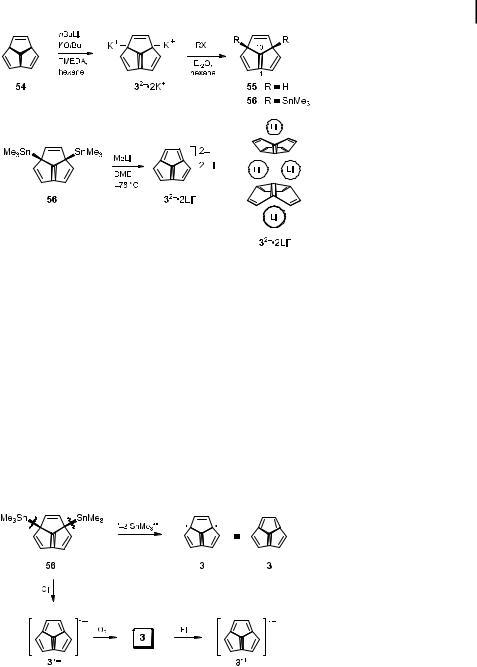
2.4 Polyunsaturated Di-, Tri-, and Oligoquinanes 43
Scheme 9.
generated, which, in fact, resembles one possible electronic state of 3 (Scheme 10). Initial attempts to perform this bond cleavage in an argon matrix both photolytically as well as thermally were unsuccessful [51]. However, due to the advances in the equipment for ionization–neutralization–reionization mass spectrometry experiments [52], it was possible to generate the neutral molecule 3 and unequivocally prove its short-lived existence in the gas phase. In this experiment, the radical anion 3. generated from 56 by chemical ionization with N2O, was mass-selected and then neutralized by collision with oxygen to give acepentalene (3), which was subsequently reionized to 3.þ [28]. The estimated lifetime of neutral 3 in the field-free zone of the mass spectrometer exceeded 1 ms, and therefore 3 can be considered as an existing species. The experimentally measured electron a nity as well as the fragmentation pattern after reionization of neutral 3 by electron impact agreed well with theoretical predictions [28].
Scheme 10. CI ¼ chemical ionization; EI ¼ electron-impact ionization.
In view of the high purity and thermal stability of dilithium acepentalenediide 32 2Liþ [48], it is the most feasible precursor of other stable acepentalene metal derivatives and

442 Oligounsaturated Five-Membered Carbocycles -- Aromatic and Antiaromatic Compounds
transition metal complexes. The reactions of 32 2Liþ with Cp2ZrCl2, Cp2HfCl2, and UCl4 gave metal complexes 57–59 of di erent coordination types and structures, as revealed by their NMR spectra [53]. The reaction of 32 2Liþ with Cp2ZrCl2 in tetrahydrofuran gave a complex, which, according to its 1H NMR spectrum, has a Cs-symmetric carbon skeleton and therefore, in analogy to the known bis(pentamethylcyclopentadienylzirconium)- trimethylenemethane complex [54], is best formulated as 57 [55]. The dilithium derivative 32 2Liþ also reacted with Cp2HfCl2 to give an oxygen-sensitive complex, the 1H NMR spectrum of which showed a single line due to the six protons on the acepentalene residue,
in accordance with the C3-symmetric structure of 58 [55]. The remarkably stable sandwich complex 59 formed from 32 2Liþ and UCl4 in THF (Scheme 11) closely resembles the uranocene formed from dilithium cyclooctatetraenediide and UCl4. The 1H NMR spectrum of complex 59 shows a very characteristic singlet at d ¼ 21 ppm, which is close to that ob-
served for the bis(cyclooctatetraenediyl)uranium complex [56].
Scheme 11.
2.4.3
Generation of C20-Fullerene
According to the isolated-pentagon rule, each five-membered ring in a spherical structure must be fully surrounded by six-membered rings [57]. Therefore, the C60-fullerene (60) has to be the smallest stable fullerene. However, the smallest conceivable spherical fullerene is the C20-fullerene (4), consisting exclusively of five-membered rings. C20-fullerene (4) exceedingly violates the isolated-pentagon rule and must therefore also be the least stable and most reactive of all fullerenes [58]. Even the less curved C36-fullerene is so reactive that it spontaneously oligomerizes in the solid state [59]. Unlike C36- and higher fullerenes, C20-
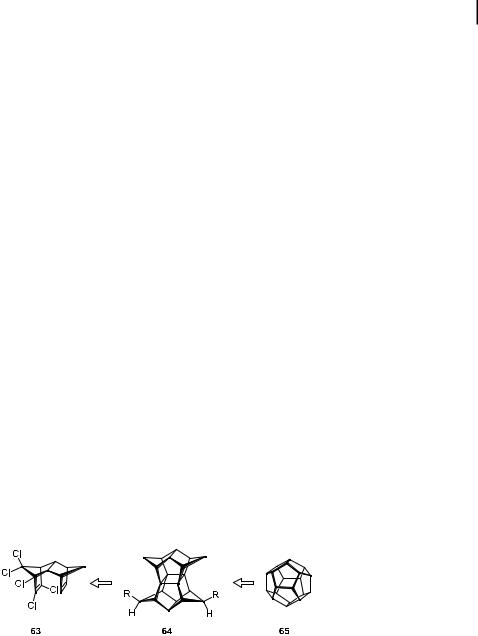
2.4 Polyunsaturated Di-, Tri-, and Oligoquinanes 45
Fig. 7. C20 clusters 4, 61, and 62.
fullerene (4) has not been observed in carbon vapor condensation or cluster annealing processes [60].
High level calculations identified C20-fullerene (4) along with the bowl-shaped isomer decadehydrocorannulene 61 and the monocyclic isomer 62 as relatively low-energy representatives of the family of C20 clusters (Figure 7) [58, 61]. To date, only the monocyclic C20 62 has been observed in laser ablation experiments on graphite [60, 62]. Recently, Prinzbach, Scott, von Issendor et al. reported the first spectroscopic characterization of the other two highly strained C20 clusters 4 and 61 [4]. Among these, the most appealing candidate is certainly the C20-fullerene (4). It is the carbon transliteration of Plato’s universe [53], and it beats 53 and 54 both in symmetry and beauty.
In close analogy to the successful generation of acepentalene (3), the best chance of forming C20-fullerene (4) would certainly be realized by starting from a stable precursor with exactly the same carbon skeleton as C20. Thus, the ideal starting material is the most highly symmetrical C20H20 hydrocarbon, the so-called pentagondodecahedrane (65), which also represents the lowest energy structure of all (CH)20 isomers. The first synthesis of 65 by Paquette et al. has been a landmark in organic synthesis [64]. In the meantime, Prinzbach et al. have developed several dramatically improved approaches to dodecahedrane (65) by the so-called isodrine-pagodane route, i.e. via 63 and 64 (Scheme 12) [65].
Scheme 12.
The stepwise introduction of double bonds into the saturated skeleton of dodecahedrane (65) has been pursued for quite some time, since Paquette et al. reported the b-elimination of trifluoroacetic acid from (trifluoroacetoxy)dodecahedrane (66) induced by hydroxide and methoxide ions in an ion cyclotron resonance mass spectrometer and inferred indirectly the

462 Oligounsaturated Five-Membered Carbocycles -- Aromatic and Antiaromatic Compounds
existence of dodecahedrene (68) in the gas phase (Scheme 13) [66]. Subsequently, Prinzbach et al. systematically developed approaches to several highly strained oligodehydrododecahedranes by b-eliminations on the dodecahedrane skeleton [67]. According to their studies, pure dodecahedrene (68) can be isolated upon dehydrobromination of bromododecahedrane (67) [68] induced by the strongly basic naked fluoride ion provided by the iminophosphorane
base ‘‘P2F’’ developed by Schwesinger et al. [59] (Scheme 13). The fact that dodecahedrene (68), with its highly out-of-plane bent CbC double bond (c ¼ 43.5 , Figure 8), can be iso-
lated, is quite remarkable on its own, but even more remarkable is the observation that 68 dimerizes only under forcing conditions (around 300 C) [70]. Such a degree of kinetic stabilization was unexpected, but can be attributed to the e cient steric shielding by four allylic hydrogen atoms, which are all rigidly held in eclipsed orientations adjacent to the double bond on the surface of 68. The dihydroacepentalene (55), with a similarly pyramidalized double bond (c ¼ 37 , Figure 8) but with only two eclipsed allylic hydrogens protecting it, cannot be isolated or even observed as a monomer at temperatures higher than 80 C (see above) [50].
Scheme 13.
Dodecahedradiene 70 has also been prepared and isolated as a stable compound [68, 71]. The highest yields (up to 70%) were obtained by flash vacuum pyrolysis of the bis(lactone) 69, which can easily be prepared along the pagodane route (cf. Scheme 12) [72]. The calculated degree of pyramidalization of the double bonds in 70 (c ¼ 42.8 ) is slightly smaller than that in dodecahedrene 68 (Figure 8).
Fig. 8. Structural features of dihydroacepentalene 55 and dodecahedrene 68.
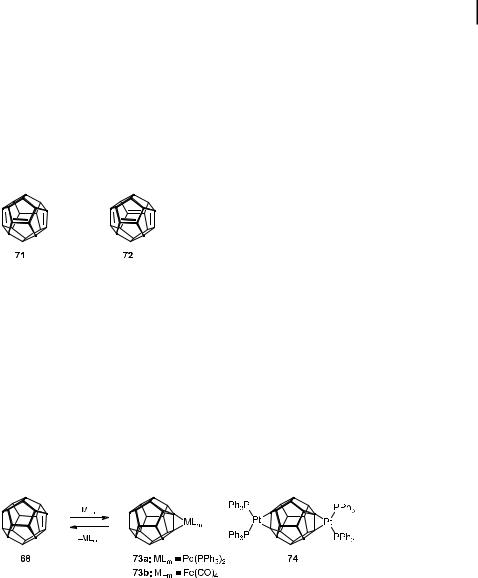
2.4 Polyunsaturated Di-, Tri-, and Oligoquinanes 47
Oligodehydrododecahedrane derivatives with an even greater degree of unsaturation have also been approached by Prinzbach et al. [67, 68, 70, 73, 74]. While the monoene 68 and diene 70 can be obtained as single regioisomers, the possibility of forming double bond isomers became a serious problem for the characterization of more highly unsaturated structures generated by dehydrobromination of triand tetrabromododecahedrane derivatives with the Schwesinger base ‘‘P2F’’. In fact, due to the number of regioisomers obtained, no pure triene or tetraene could be isolated. Nevertheless, trapping experiments with dienes in Diels–Alder reactions, as well as extensive mass spectrometric analyses, confirmed the existence of dodecahedratriene and -tetraene isomers 71 and 72, respectively.
In analogy to acepentalene (3) and dihydroacepentalene 55 [75], the extremely strained double bonds in unsaturated dodecahedranes can be protected by metal complexation. Due to the high degree of pyramidalization, the HOMOs are slightly raised and the LUMOs significantly lowered and hence d10 metals (Pt, Pd, and Ni) are good coordinators for these double bonds. The steric protection of the double bonds by the allylic hydrogen atoms (see above) did not prohibit the formation of these metal complexes, as predicted for such pyramidalized double bonds [76]. Metal coordination of dodecahedrene 68, e.g. by a Pd(PPh3)2 unit, occurred smoothly upon treatment with Pd(PPh3)4 at room temperature to give the crystalline air-sensitive complex 73a (Scheme 14) [77]. The binuclear platinum complex 74 of the diene was characterized by X-ray crystal structure analysis, which revealed an elongation of the double bonds by ca. 0.11 A˚ and an increase in the pyramidalization by 7 .
Scheme 14.
As a reversible protection measure, complexation with a Fe(CO)4 moiety appeared to be most promising. The monoene 68 was indeed found to react smoothly with Fe(CO)5 at room temperature to give the tetracarbonyliron complex 73b in 75% yield after crystallization. The complex 73b proved to be stable for days in air as a solid and in solution (CHCl3, benzene), and its ligand 68 can be conveniently liberated under mild oxidative conditions [Ce(NO3)4/ MeOH/THF] at room temperature (Scheme 14) [77]. Although the use of metal complexation as a protection method for such compounds with highly pyramidalized double bonds works well for the monoene 68 and the diene 70, the complexation of more highly unsatu-
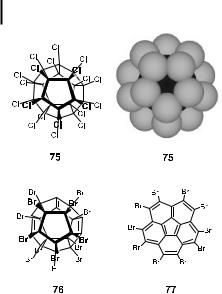
48 2 Oligounsaturated Five-Membered Carbocycles -- Aromatic and Antiaromatic Compounds
Fig. 9. Perhalogenated derivatives of dodecahedrane 75, 76, and corannulene 77.
rated dehydrododecahedranes is hampered by the occurrence of regioisomers, as in the case of 71 and 72, and by steric overcrowding on the surface if the metal bears additional bulky ligands.
In order to get from the stable, fully saturated dodecahedrane 65 with the correct connectivity of the carbon skeleton of 4 to the fully unsaturated C20-fullerene, ten (!) double bonds have to be introduced without breaking any of the CaC bonds of the carbon skeleton [70]. The working hypothesis for the transformation of 65 into 4 was to replace most or all of the strongly bound hydrogen atoms by more weakly bound chlorine or bromine atoms. The perhalogenated derivatives of 65 would then be submitted to conditions under which elimination of the halogen atoms could occur, e.g. electron impact in a mass spectrometer. While the perchlorination of dodecahedrane (65) could indeed be achieved to give mixtures of compounds with up to 20 chlorine substituents on the C20 skeleton, i.e. 75 (Figure 9), subsequent electron impact mass spectrometric investigation in the positive ion mode was not indicative of consecutive elimination of chlorine atoms following ionization, but rather of significant cage fragmentation [73].
Functionalization of 65 with more weakly bound bromine atoms appeared to be the solution to this dilemma. However, due to the increased bulk of the bromine substituents and the resulting steric repulsion on the surface of 65 (compare structure 75, Figure 9), substitution of all the hydrogen atoms could never be achieved with any of a variety of bromination protocols [78]. Only when a brute force method (neat Br2, reflux, and irradiation with a 450 W halogen lamp for 3 d) was applied, could a highly brominated product with an average elemental composition of C20HBr13, corresponding to 76, be reproducibly isolated [4, 70]. Spectroscopic evidence showed that the obtained material consisted of a multitude of isomeric trienes, such as 76, with a range of compositions C20H0–3Br14–11, which, in spite of their highly pyramidalized double bonds (c > 50 ) (cf. Figure 8), proved to be insensitive to oxygen. The three double bonds that were introduced during the bromination process by
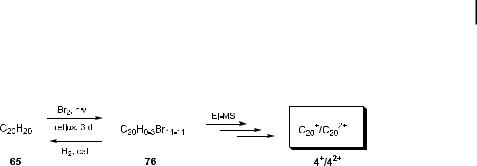
2.4 Polyunsaturated Di-, Tri-, and Oligoquinanes 49
spontaneous elimination reactions apparently provide relief from the steric overcrowding at the molecular periphery. Catalytic hydrogenation of the bromination product 76 led back to the fully saturated dodecahedrane (65), proving that the cage survived the harsh conditions (Scheme 15) [73].
Scheme 15.
The cationic mode mass spectrum of the [C20H0–3Br14–11] sample showed singly and doubly charged C20 ions with up to 14 bromine atoms attached. The remarkably high intensities of the C20þ and C20 2þ ion peaks and the very low abundance of smaller fragments attested to a remarkable kinetic stability of the C20 cluster 4. The anionic mode mass spectra obtained from brominated dodecahedrane 76 and perbrominated corannulene 77 resembled those of the cationic mode mass spectra, and again showed a high kinetic stability of the respective C20 clusters. Obviously, these mass spectra alone are not su cient proof for the existence of the C20-fullerene (4), nor can they reveal which isomer of the three, i.e. 4, 61, or 62, was actually formed. Therefore, the C20 species obtained from three di erent sources, i.e. from the perbrominated cage 76, from decabromocorannulene 77 [79], and from laserablated graphite, the latter known to yield the monocycle 62, were converted to their anions and these were examined with a photoelectron (PE) spectrometer that was directly linked to the mass spectrometer [80]. In these experiments, a special ion source was used to generate an ion beam that was stable for several hours even though only a few milligrams of the respective materials were at hand. The PE spectra of the mass-selected C20. clusters obtained from these three sources showed significantly di erent features. While the PE spectrum of the monocycle 62 had previously been assigned in combination with ion mobility experiments [60d], the spectra of the other two isomers 4 and 61 had not been observed before. The monocycle 62 was found to have an electron a nity of 2.44 (G0.03) eV and its spectrum exhibited a vibrational progression of 2260 (G100) cm 1. The bowl isomer 61 generated from decabromocorannulene 77 showed a significantly lower electron a nity of 2.17 (G0.03) eV, but a similar vibrational progression of 2060 (G50) cm 1. The cage isomer 4 generated from the oligobrominated dodecahedrane 76 had an electron a nity of 2.25 (G0.03) eV and exhibited a vibrational progression of 730 (G79) cm 1; at 0.27 eV above the first ionization threshold, another progression with a spacing of 260 (G40) cm 1 set in. These observations clearly demonstrate that three di erent C20 clusters were obtained. Similarly to the highly strained acepentalene (3), the C20 clusters had lifetimes of at least the total flight time (0.4 ms) in the gas phase.
While the PE spectra of the bowl 61 and the monocycle 62 are in good agreement with theoretical predictions, the situation is more complex for the C20-fullerene (4). Although the observed 730 cm 1 progression is consistent with that expected for a closed ‘‘polyolefinic’’ cage 4, the theoretical confirmation of the PE spectrum of 4 remains a challenge for quantum mechanical methods. The ground-state symmetry of the neutral C20-fullerene (4) is currently disputed in the literature [81], yet it is indispensable for the prediction of the vibrational modes excited upon electron attachment.

50 2 Oligounsaturated Five-Membered Carbocycles -- Aromatic and Antiaromatic Compounds
Further experimental confirmation of the existence of C20-fullerene 4 might be provided by the endohedral incorporation of small atoms, such as He, into the cage. Such an incorporation is known for C60-fullerene (60), and the existence of He@C60 has additionally confirmed the cage structure of these molecules [82]. More recently, Cross, Saunders, and Prinzbach demonstrated that such a helium incorporation is even possible for the much smaller cage of the fully saturated dodecahedrane (65) [83]. However, the yield of this process (0.01 % He@C20H20) is as yet too low to enable one to use the product as a precursor for the generation of the fully unsaturated He@C20. The possibility of stabilizing and isolating C20-fullerene as a metal complex, as has been demonstrated for pentalene (2) and acepentalene (3), will, however, largely depend on the successful synthesis of suitable precursors in the future.
Acknowledgements
The authors are indebted to Stefan Beußhausen, Go¨ttingen, for drawing the figures and schemes, and to Dr. Burkhard Knieriem, Go¨ttingen, for careful proofreading of the final manuscript. R. H. is grateful to the Gottlieb Daimlerand Karl Benz-Stiftung as well as the Fonds der Chemischen Industrie for financial support.
References
1 J. Thiele, Chem. Ber. 1901, 34, 68.
2R. Haag, A. de Meijere, Top. Curr. Chem. 1998, 196, 137, and refs. cited
therein.
3 A. de Meijere, R. Haag, F.-M. Schu¨ngel, S. I. Kozhushkov, I. Emme, Pure Appl. Chem. 1999, 71, 253.
4H. Prinzbach, A. Weiler, P. Landenberger, F. Wahl, J. Wo¨rth, L. T. Scott, M. Gelmont, D. Olevano, B. von Issendorff, Nature 2000, 407, 60.
5a) J. B. Lambert, L. Lin, V. Rassolov,
Angew. Chem. 2002, 114, 1487; Angew. Chem. Int. Ed. 2002, 41, 1429; b) M. Otto, D. Scheschkewitz, T. Kato, M. M. Midland, J. B. Lambert, G. Bertrand,
Angew. Chem. 2002, 114, 2379; Angew. Chem. Int. Ed. 2002, 41, 2275; c) T. Mu¨ller, Angew. Chem. 2002, 114, 2380; Angew. Chem. Int. Ed. 2002, 41, 2276;
d)J. B. Lambert, Angew. Chem. 2002, 114, 2382; Angew. Chem. Int. Ed. 2002, 41, 2278;
e)J. N. Jones, A. H. Cowley, C. L. B.
Macdonald, Chem. Commun. 2002, 1520.
6a) H. Jiao, P. v. R. Schleyer, Y. Mo, M. A. McAllister, T. T. Tidwell, J. Am.
Chem. Soc. 1997, 119, 7075; b) B. Reindl, P. v. R. Schleyer, J. Comp. Chem. 1998,
19, 1402.
7 A. de Meijere, I. Emme, S. Redlich, C. Freudenberger, H.-U. Siehl, P. R. Schreiner, unpublished results.
8M. Saunders, R. Berger, A. Jaffe, J. M. McBride, J. O. Neill, R. Breslow, J. M. Hoffmann, Jr., C. Perchonok, E.
Wasserman, R. S. Hutton, V. J. Kuck, J. Am. Chem. Soc. 1973, 95, 3017.
9R. Breslow, R. Hill, E. Wasserman, J. Am. Chem. Soc. 1964, 86, 5349.
10R. Breslow, H. W. Chang, W. A. Yager,
J. Am. Chem. Soc. 1963, 85, 2033.
11W. Broser, H. Kurreck, P. Siegle, Chem. Ber. 1967, 100, 788.
12H. Sitzmann, H. Bock, R. Boese, T. Dezember, Z. Havlas, W. Kaim, M. Moscherosch, L. Zanathy, J. Am. Chem. Soc. 1993, 115, 12003.
13I. Emme, S. Redlich, T. Labahn, J. Magull, A. de Meijere, Angew. Chem.
2002, 114, 811; Angew. Chem. Int. Ed.
2002, 41, 786.
14H. Hopf, Classics in Hydrocarbon Chemistry, Wiley-VCH, Weinheim, 2000, pp. 269–271.
15M. Oda, in Houben-Weyl, Methods of Organic Chemistry, Vol. E17a (Ed.: A. de Meijere), Thieme, Stuttgart, 1997, pp. 2966–2972.
|
|
|
References |
51 |
|
J. Thiele, H. Balhorn, Justus Liebigs Ann. |
|
|
|
16 |
37 |
T. Bally, A. Chai, M. Neuenschwander, |
||
|
Chem. 1906, 348, 1. |
|
Z. Zhu, J. Am. Chem. Soc. 1997, 119, |
|
17 |
J. Thiec, J. Wiemann, Bull. Soc. Chim. Fr. |
|
1869. |
|
|
1960, 1066. |
38 |
T. J. Katz, M. Rosenberger, J. Am. Chem. |
|
18 |
E. Sturm, K. Hafner, Angew. Chem. 1964, |
|
Soc. 1962, 84, 865. |
|
|
76, 862; Angew. Chem. Int. Ed. Engl. 1964, |
39 |
J. J. Stezowski, H. Hoier, D. Wilhelm, |
|
|
3, 749. |
|
T. Clark, P. v. R. Schleyer, J. Chem. Soc., |
|
19 |
H. Schaltegger, M. Neuenschwander, |
|
Chem. Commun. 1985, 1263. |
|
|
D. Meuche, Helv. Chim. Acta 1965, 48, 955. |
40 |
A. G. Griesbeck, J. Org. Chem. 1989, 54, |
|
20 |
H. Du¨rr, B. Ruge, Angew. Chem. 1972, 84, |
|
4981. |
|
|
215; Angew. Chem. Int. Ed. Engl. 1972, 11, |
41 |
A. de Meijere, S. I. Kozhushkov, D. |
|
|
225. |
|
Faber, V. Bagutskii, R. Boese, T. |
|
21 |
H. Du¨rr, B. Ruge, H. Schmitz, Angew. |
|
Haumann, R. Walsh, Eur. J. Org. Chem. |
|
|
Chem. 1973, 85, 616; Angew. Chem. Int. Ed. |
|
2001, 3607. |
|
|
Engl. 1973, 12, 577. |
42 |
K. Hafner, Angew. Chem. 1973, 85, 958; |
|
22 |
H. E. Simmons, T. Fukunaga, J. Am. |
|
Angew. Chem. Int. Ed. Engl. 1973, 12, 925. |
|
|
Chem. Soc. 1967, 89, 5208. |
43 |
L. A. Paquette, Topics Curr. Chem. 1984, |
|
23 |
R. Hoffmann, A. Imamaura, D. G. Zeiss, |
|
119, and refs. cited therein. |
|
|
J. Am. Chem. Soc. 1967, 89, 5215. |
44 |
E. E. Bunel, L. Valle, N. L. Jones, P. J. |
|
24 |
E. Haselbach, M. Allan, A.-C. |
|
Carroll, C. Barra, M. Gonzales, N. |
|
|
Sergenton, T. Bally, P. Bednarek, A. de |
|
Munoz, G. Visconti, A. Aizaman, J. M. |
|
|
Meijere, S. Kozhushkov, S. Grimme, |
|
Manriwuez, J. Am. Chem. Soc. 1988, 110, |
|
|
Helv. Chim. Acta 2001, 84, 1670. |
|
6596. |
|
25 |
A. Streitwieser Jr., Molecular Orbital |
45 |
a) K. Jonas, B. Gabor, R. Mynott, K. |
|
|
Theory for Organic Chemists, Wiley, New |
|
Angermund, O. Heinemann, C. Kru¨ger, |
|
|
York, 1961, and refs. cited therein. |
|
Angew. Chem. 1997, 109, 1790; Angew. |
|
26 |
R. Bloch, R. A. Marty, P. de Mayo, J. |
|
Chem. Int. Ed. Engl. 1997, 36, 1712; b) K. |
|
|
Am. Chem. Soc. 1971, 93, 3071. |
|
Jonas, P. Kolb, G. Kollbach, B. Gabor, |
|
27 |
K. Hafner, R. Do¨nges, E. Goedecke, R. |
|
R. Mynott, K. Angermund, O. |
|
|
Kaiser, Angew. Chem. 1973, 85, 362; |
|
Heinemann, C. Kru¨ger, Angew. Chem. |
|
|
Angew. Chem. Int. Ed. Engl. 1973, 12, 337. |
|
1997, 109, 1793; Angew. Chem. Int. Ed. |
|
28 |
R. Haag, D. Schro¨der, T. Zywietz, H. |
|
Engl. 1997, 36, 1714. |
|
|
Jiao, H. Schwarz, P. v. R. Schleyer, A. |
46 |
R. B. Woodward, T. Fukunaga, R. C. |
|
|
de Meijere, Angew. Chem. 1996, 108, 1413; |
|
Kelly, J. Am. Chem. Soc. 1964, 86, 3162. |
|
|
Angew. Chem. Int. Ed. Engl. 1996, 35, 1317. |
47 |
T. Lendvai, T. Friedel, H. Butenscho¨n, |
|
29 |
L. A. Paquette, Top. Curr. Chem. 1979, 79, |
|
T. Clark, A. de Meijere, Angew. Chem. |
|
|
80. |
|
1986, 98, 734; Angew. Chem. Int. Ed. Engl. |
|
30 |
E. LeGoff, J. Am. Chem. Soc. 1962, 84, |
|
1986, 25, 719. |
|
|
3975. |
48 |
R. Haag, R. Fleischer, D. Stalke, A. de |
|
31 |
K. Hafner, H. U. Su¨ss, Angew. Chem. |
|
Meijere, Angew. Chem. 1995, 107, 1642; |
|
|
1973, 85, 626; Angew. Chem. Int. Ed. Engl. |
|
Angew. Chem. Int. Ed. Engl. 1995, 34, |
|
|
1973, 12, 575. |
|
1492. |
|
32 |
J. W. Armit, R. Robinson, J. Chem. Soc. |
49 |
R. Haag, F.-M. Schu¨ngel, B. Ohlhorst, |
|
|
1922, 121, 827; 1925, 127, 1604. |
|
T. Lendvai, H. Butenscho¨n, T. Clark, |
|
33 |
N. C. Baird, R. M. West, J. Am. Chem. |
|
M. Noltemeyer, T. Haumann, R. Boese, |
|
|
Soc. 1971, 93, 3072. |
|
A. de Meijere, Chem. Eur. J. 1998, 4, |
|
34 |
P. Bischof, R. Gleiter, K. Hafner, K. H. |
|
1192. |
|
|
Knauer, J. Spanget-Larsen, H. U. Su¨ss, |
50 |
a) R. Haag, B. Ohlhorst, A. Schuster, |
|
|
Chem. Ber. 1978, 111, 932. |
|
D. Kuck, A. de Meijere, J. Chem. Soc. |
|
35 |
T. K. Zywietz, H. Jiao, P. v. R. Schleyer, |
|
Chem. Commun. 1993, 1727; b) R. Haag, |
|
|
A. de Meijere, J. Org. Chem. 1997, 63, |
|
B. Ohlhorst, M. Noltemeyer, R. |
|
|
3417, and refs. cited therein. |
|
Fleischer, D. Stalke, A. Schuster, D. |
|
36 |
R. F. C. Brown, N. Choi, F. W. |
|
Kuck, A. de Meijere, J. Am. Chem. Soc. |
|
|
Eastwood, Aust. J. Chem. 1995, 48, 185. |
|
1995, 117, 10474. |
|

52 2 Oligounsaturated Five-Membered Carbocycles -- Aromatic and Antiaromatic Compounds
51 |
R. Haag, H. P. Reisenauer, G. Maier, A. |
67 |
J. Reinbold, E. Sackers, T. Osswald, K. |
|
de Meijere, unpublished results. |
|
Weber, A. Weiler, T. Voss, D. Hunkler, |
52 |
N. Goldberg, H. Schwarz, Acc. Chem. |
|
J. Wo¨rth, L. Knothe, F. Sommer, M. |
|
Res. 1994, 27, 347. |
|
Morgner, B. von Issendorff, H. |
53 |
R. Haag, Dissertation, Universita¨t |
|
Prinzbach, Chem. Eur. J. 2002, 8, 509. |
|
Go¨ttingen, 1995. |
68 |
J.-P. Melder, K. Weber, A. Weiler, E. |
54 |
G. E. Herberich, C. Kruder, U. |
|
Sackers, H. Fritz, D. Hunkler, H. |
|
Englert, Angew. Chem. 1994, 106, 2589; |
|
Prinzbach, Res. Chem. Intermed. 1996, 22, |
|
Angew. Chem. Int. Ed. Engl. 1994, 33, |
|
667. |
|
2465. |
69 |
R. Schwesinger, J. Willaredt, H. |
55 |
R. Haag, F.-M. Schu¨ngel, P. Poremba, F. |
|
Schlemper, M. Keller, D. Schmitt, H. |
|
Edelmann, A. de Meijere, unpublished |
|
Fritz, Chem. Ber. 1994, 127, 2435. |
|
results. |
70 |
H. Prinzbach, K. Weber, Angew. Chem. |
56 |
A. Streitwieser Jr., S. A. Kinsley, in |
|
1994, 106, 2329; Angew. Chem. Int. Ed. |
|
Fundamental and Technological Aspects of |
|
Engl. 1994, 33, 2239. |
|
Organo-f-element Chemistry (Eds.: T. J. |
71 |
E. E. B. Campbell, R. Tellgmann, F. |
|
Marks, I. L. Fragala), Reidel, Dordrecht, |
|
Wahl, H. Prinzbach, Int. J. Mass Spec. & |
|
NATO ASI Series C, Vol. 155, 1985, p. 77. |
|
Ion Processes 1994, 136, 209. |
57 |
H. W. Kroto, Nature 1987, 329, 529. |
72 |
M. Bertau, J. Leonhardt, A. Weiler, K. |
58 |
A. van Orden, R. J. Saykally, Chem. Rev. |
|
Weber, H. Prinzbach, Chem. Eur. J. |
|
1998, 98, 2313, and refs. cited therein. |
|
1996, 2, 570. |
59 |
a) C. Piskoti, J. Yarger, A. Zettl, Nature |
73 |
a) F. Wahl, J. Wo¨rth, H. Prinzbach, |
|
1998, 393, 771; b) P. W. Fowler, T. |
|
Angew. Chem. 1993, 105, 1788; Angew. |
|
Heine, K. M. Rogers, J. P. B. Sandall, G. |
|
Chem. Int. Ed. Engl. 1993, 32, 1722. |
|
Seifert, F. Zerbetto, Chem. Phys. Lett. |
74 |
R. Pinkas, J. P. Melder, K. Weber, D. |
|
1999, 300, 369; c) A. Koshio, M. |
|
Hunkler, H. Prinzbach, J. Am. Chem. |
|
Inakuma, T. Sugai, H. Shinohara, J. |
|
Soc. 1993, 115, 7173. |
|
Am. Chem. Soc. 2000, 122, 398. |
75 |
H. Butenscho¨n, Angew. Chem. 1997, 109, |
60 |
a) S. Yang, K. J. Taylor, M. J. Craycraft, |
|
1771; Angew. Chem. Int. Ed. 1997, 36, |
|
J. Conceicao, C. L. Pettiette, O. |
|
1695. |
|
Cheshnovsky, R. E. Smalley, Chem. Phys. |
76 |
W. T. Borden, Chem. Rev. 1989, 89, 1095. |
|
Lett. 1988, 144, 431; b) G. von Helden, M. |
77 |
T. Oßwald, M. Keller, C. Janiak, M. |
|
T. Hsu, N. G. Gotts, P. R. Kemper, M. T. |
|
Kolm, H. Prinzbach, Tetrahedron Lett. |
|
Bowers, Chem. Phys. Lett. 1993, 204, 15; c) |
|
2000, 41, 1631. |
|
H. Handschuh, Phys. Rev. Lett. 1995, 74, |
78 |
J. Cioslowsky, L. Edgington, B. B. |
|
1095; d) T. Wakabayashi, M. Kohno, Y. |
|
Stefanov, J. Am. Chem. Soc. 1995, 17, |
|
Achiba, H. Shiramaru, T. Momose, T. |
|
10381. |
|
Shida, K. Naemura, Y. Tobe, J. Chem. |
79 |
L. T. Scott, P.-C. Cheng, M. M. |
|
Phys. 1997, 107, 4783. |
|
Hashemi, M. S. Bratcher, D. T. Meyer, |
61 |
G. E. Scuseria, Science 1996, 271, 942. |
|
H. B. Warren, J. Am. Chem. Soc. 1997, |
62 |
G. von Helden, N. G. Gotts, M. T. |
|
119, 10963. |
|
Bowers, Nature 1993, 363, 60. |
80 |
H. Haberland, H. Kornmeier, C. |
63 |
E. Heilbronner, J. D. Dunitz, in |
|
Ludewigt, A. Risch, M. A. Schmidt, Rev. |
|
Reflections on Symmetry, VCH, Weinheim, |
|
Sci. Instrum. 1991, 62, 2621. |
|
1993. |
81 |
a) G. Galli, F. Gygi, J. C. Golaz, Phys. |
64 |
L. A. Paquette, Chem. Rev. 1989, 89, 1051. |
|
Rev. B 1998, 57, 1860; b) G. Dusˇkesas, S. |
65 |
M. Bertau, F. Wahl, A. Weiler, K. |
|
Larsson, Theor. Chem. Acc. 1997, 97, 110. |
|
Scheumann, J. Worth, M. Keller, H. |
82 |
a) M. Saunders, A. Jime´nez-Va´zquez, R. |
|
Prinzbach, Tetrahedron 1997, 53, 10029. |
|
J. Cross, R. J. Poreda, Science 1996, 259, |
66 |
J. P. Kiplinger, F. R. Tollens, A. G. |
|
1428; b) M. Saunders, R. J. Cross, H. A. |
|
Marshall, T. Kobayashi, D. R. |
|
Jime´nez-Va´zquez, R. Shimshi, A. |
|
Lagerwall, L. A. Paquette, J. E. |
|
Khong, Science 1996, 271, 1693. |
|
Bartmess, J. Am. Chem. Soc. 1989, 111, |
83 |
R. J. Cross, M. Saunders, H. Prinzbach, |
|
6914. |
|
Org. Lett. 1999, 1, 1479. |
